Ditapis dengan
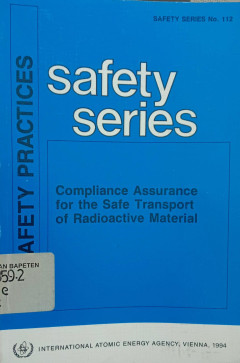
Safety Series No. 112. SAFETY PRACTICES. Compliance Assurance For The Sale Tr…
The 1985 Edition of the IAEA’s Regulations for the Safe Transport of Radioactive Material reinforced the requirement placed on competent authorities to establish compliance assurance programmes that aim at ensuring that the Regulations are met in practice. This book is intended to provide further guidance on developing and implementing compliance assurance programmes to be used by competent a…
- Edisi
- -
- ISBN/ISSN
- -
- Deskripsi Fisik
- -
- Judul Seri
- Safety Series No. 112
- No. Panggil
- 604 IAE S
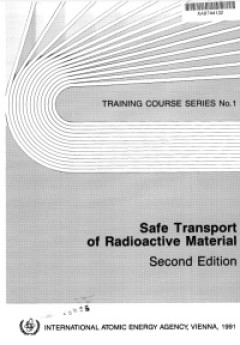
Safe Transport of Radioactive Material, Second Edition
In 1991, the International Atomic Energy Agency published Training Course Series No. 1 (TCS-1), a training manual that provides in 20 chapters a detailed discussion of the background, philosophy, technical bases and requirements and implementation aspects of the Regulations for the Safe Transport of Radioactive Material. The Transport Regulations are widely implemented by the IAEA's Member Stat…
- Edisi
- -
- ISBN/ISSN
- -
- Deskripsi Fisik
- 365 p. : Illus. ; 30 cm
- Judul Seri
- Training Course Series No. 1
- No. Panggil
- 621.039746 IAE s
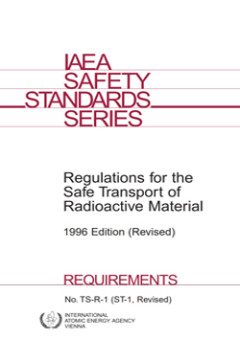
Regulations for the Safe Transport of Radioactive Material, 1996 Edition (Rev…
This publication, Safety Standards Series No. TS-R-1, is an updated version of Safety Standards Series No. ST-1, which was a revised version of Safety Series No. 6 superseding all previous edition. It also includes the revision of Safety Series No. 80, Schedules of Requirements for the Transport of Specified Types of Radioactive Material Consignments (As Amended in 1990). These Regulations, fir…
- Edisi
- -
- ISBN/ISSN
- 92-0-100500-8
- Deskripsi Fisik
- 220p;714KB
- Judul Seri
- -
- No. Panggil
- 614.864 IAE R

Appraisal for Panama of the Safety of the Transport of Radioactive Material |…
The IAEA has the specific statutory function within the United Nations system of establishing standards of safety for the protection of health against exposure to ionizing radiation. As part of this mandate, the IAEA has issued Regulations for the Safe Transport of Radioactive Material, and has also established the Transport Safety Appraisal Service (TranSAS) to carry out, at the request of Sta…
- Edisi
- TranSAS-5
- ISBN/ISSN
- 92-0-109904-5
- Deskripsi Fisik
- 86p;557kb
- Judul Seri
- -
- No. Panggil
- 614.864 IAE A
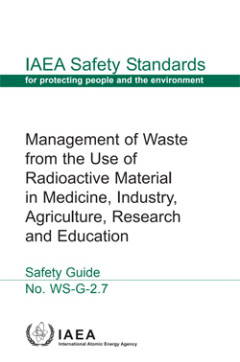
Management of Waste from the Use of Radioactive Material in Medicine, Industr…
This Safety Guide provides recommendations and guidance on the fulfilment of the safety requirements on management of radioactive waste. It covers the roles and responsibilities of different bodies involved in the predisposal management of radioactive waste and in the handling and processing of radioactive material. It is intended for organizations generating and handling radioactive waste or h…
- Edisi
- 2.7
- ISBN/ISSN
- 9201137044 / 1020525X
- Deskripsi Fisik
- 73 p. : Illus. ; 24 cm
- Judul Seri
- Safety Standards Series No. WS-G-2.7
- No. Panggil
- 333.7 IAE M
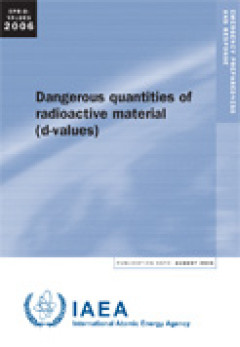
Dangerous quantities of radioactive material (D-values)
A D value is the quantity of radioactive material which is considered a dangerous source. A dangerous source is one that, if uncontrolled, could result in death or a permanent injury which decreases that person’s quality of life. Various IAEA documents concerning emergency preparedness and safety and security of radioactive sources list D values for a limited set of radionuclides. This docume…
- Edisi
- -
- ISBN/ISSN
- -
- Deskripsi Fisik
- 154p
- Judul Seri
- -
- No. Panggil
- 541 IAE D
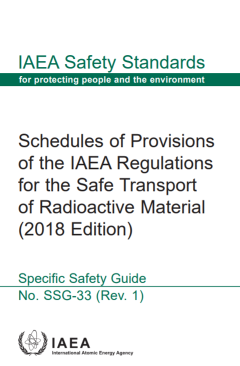
Schedules of provisions of the IAEA regulations for the safe transport of ra…
Radioactivity is a natural phenomenon and natural sources of radiation are features of the environment. Radiation and radioactive substances have many beneficial applications, ranging from power generation to uses in medicine, industry and agriculture. The radiation risks to workers and the public and to the environment that may arise from these applications have to be assessed and, if necessar…
- Edisi
- 2021
- ISBN/ISSN
- 978-92-0-121921-3
- Deskripsi Fisik
- 322 p
- Judul Seri
- IAEA Safety Standards Series No. SSG-33 (Rev. 1)
- No. Panggil
- 656.073 IAE s
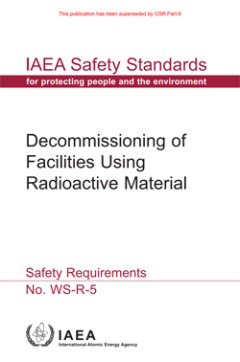
Safety Standards-Safety Requirements Decommisioning of Facilities Using Radio…
The importance of decommissioning has come to the fore in the past few years. Previously the requirements for safety during decommissioning had been considered as part of general waste management, but recently it was decided that this important part of a facility’s life needs to have definitive requirements specified. This publication provides such information.
- Edisi
- -
- ISBN/ISSN
- -
- Deskripsi Fisik
- 25 Hal
- Judul Seri
- -
- No. Panggil
- -
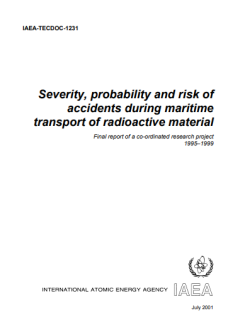
Severity, Probability and Risk of Accident During Maritime Transport of Radio…
The primary purpose of this CRP was to provide a co-ordinated international effort to assemble and evaluate relevant data using sound technical judgement concerning the effects that fires, explosions or breaches of hulls of ships might have on the integrity of radioactive material packages. The probability and expected consequences of such events could thereby be assessed. If it were shown that…
- Edisi
- -
- ISBN/ISSN
- -
- Deskripsi Fisik
- -
- Judul Seri
- IAEA-TECDOC-1231
- No. Panggil
- 363.1799 IAE s
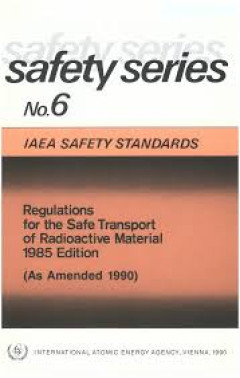
Regulations for the Safe Transport of Radioactive Material, 1985 Edition (As …
This book contain of seven section: Section I. Introduction; Section II. General provisions; Section III. Activity and fissile material limits; Section IV. Preparation, requirements and controls for shipment and for storage in transit; Section V. Requirements for radioactive materials and for packagings and packages; Section VI. Test procedures; and Section VII. Approval and administrative requ…
- Edisi
- -
- ISBN/ISSN
- 9201238908 / 00741892
- Deskripsi Fisik
- 112 p. : Illus. ; 24 cm
- Judul Seri
- Safety Series No. 6
- No. Panggil
- 539.7 IAE r
 Karya Umum
Karya Umum  Filsafat
Filsafat  Agama
Agama  Ilmu-ilmu Sosial
Ilmu-ilmu Sosial  Bahasa
Bahasa  Ilmu-ilmu Murni
Ilmu-ilmu Murni  Ilmu-ilmu Terapan
Ilmu-ilmu Terapan  Kesenian, Hiburan, dan Olahraga
Kesenian, Hiburan, dan Olahraga  Kesusastraan
Kesusastraan  Geografi dan Sejarah
Geografi dan Sejarah